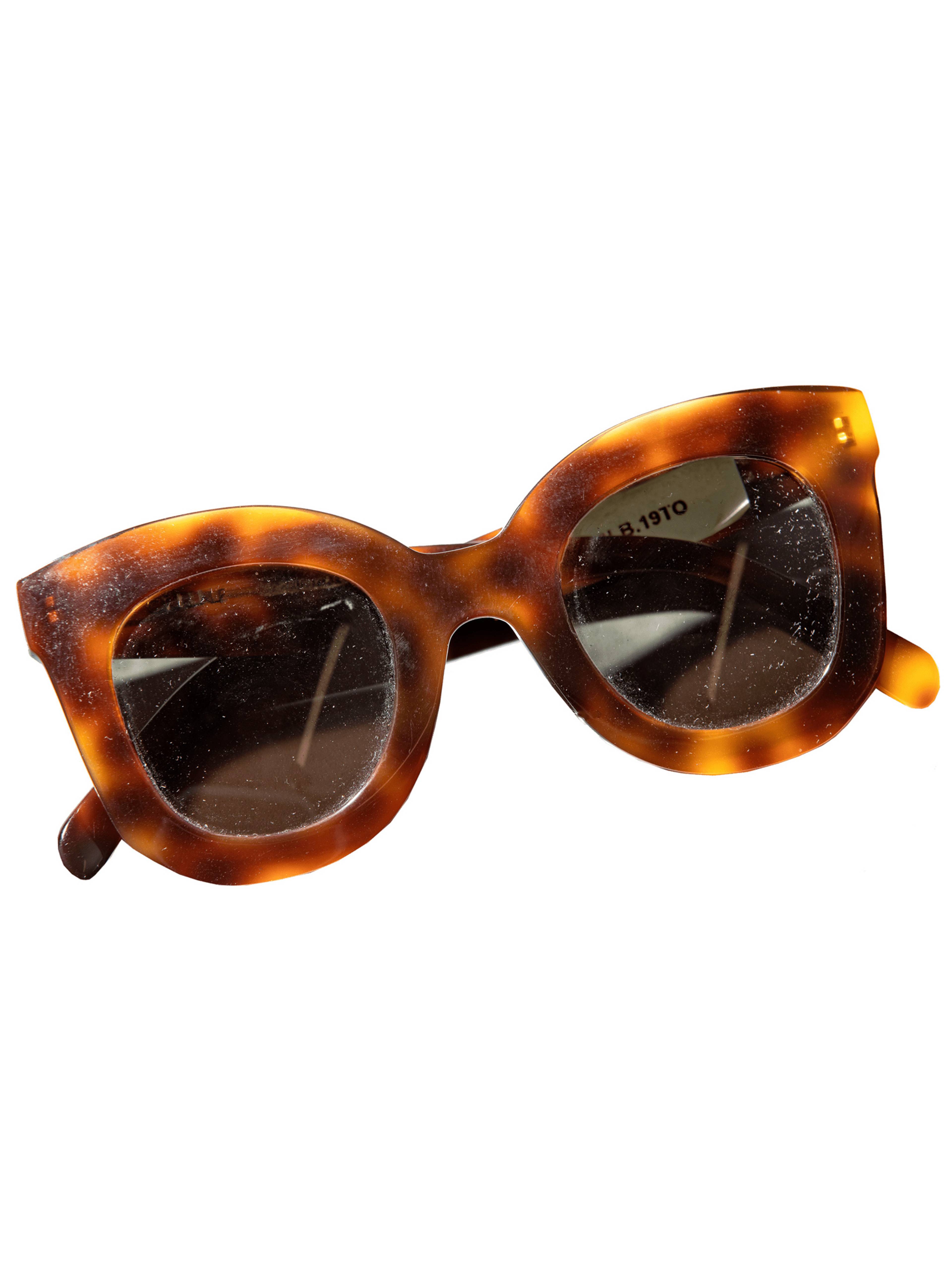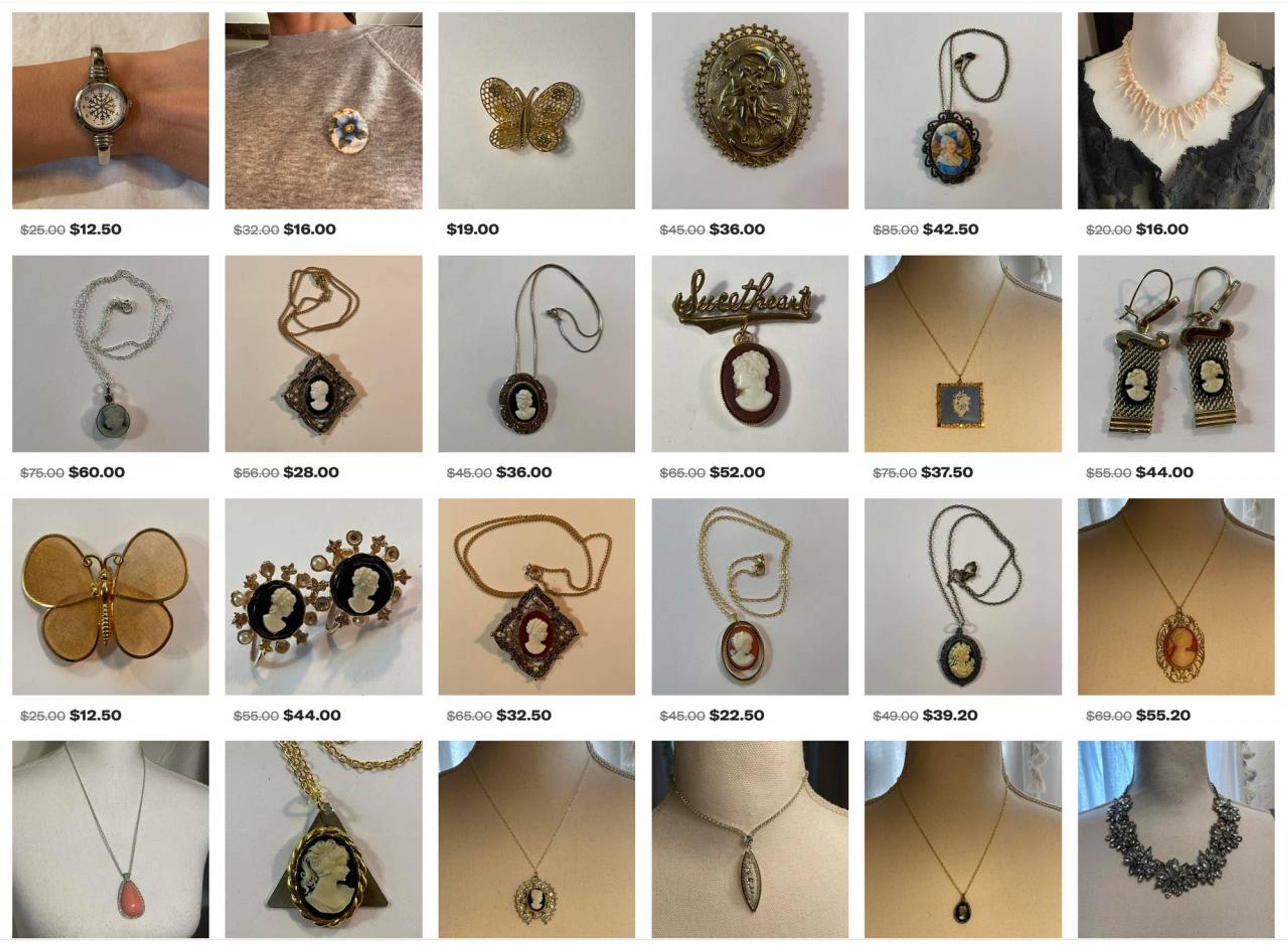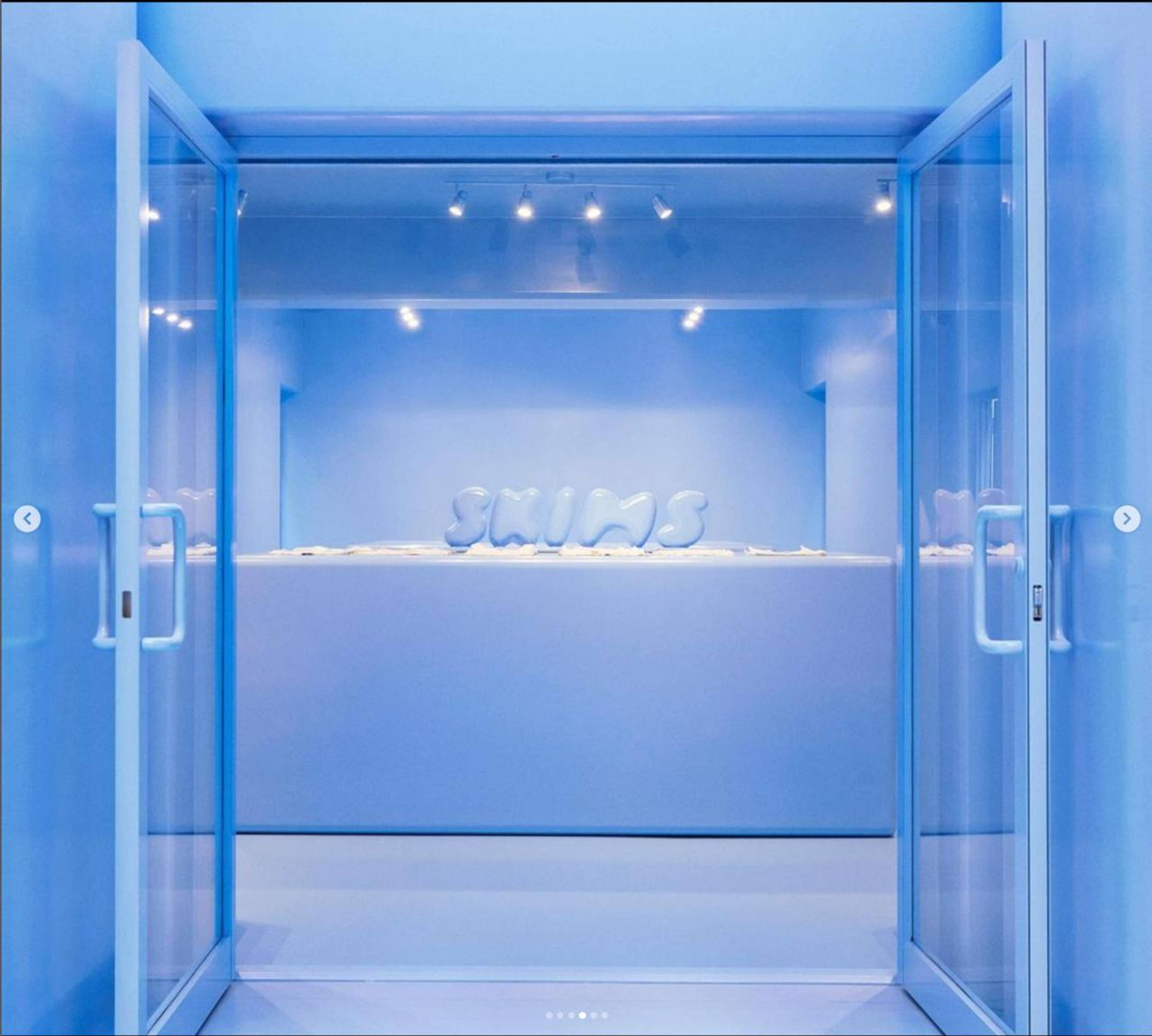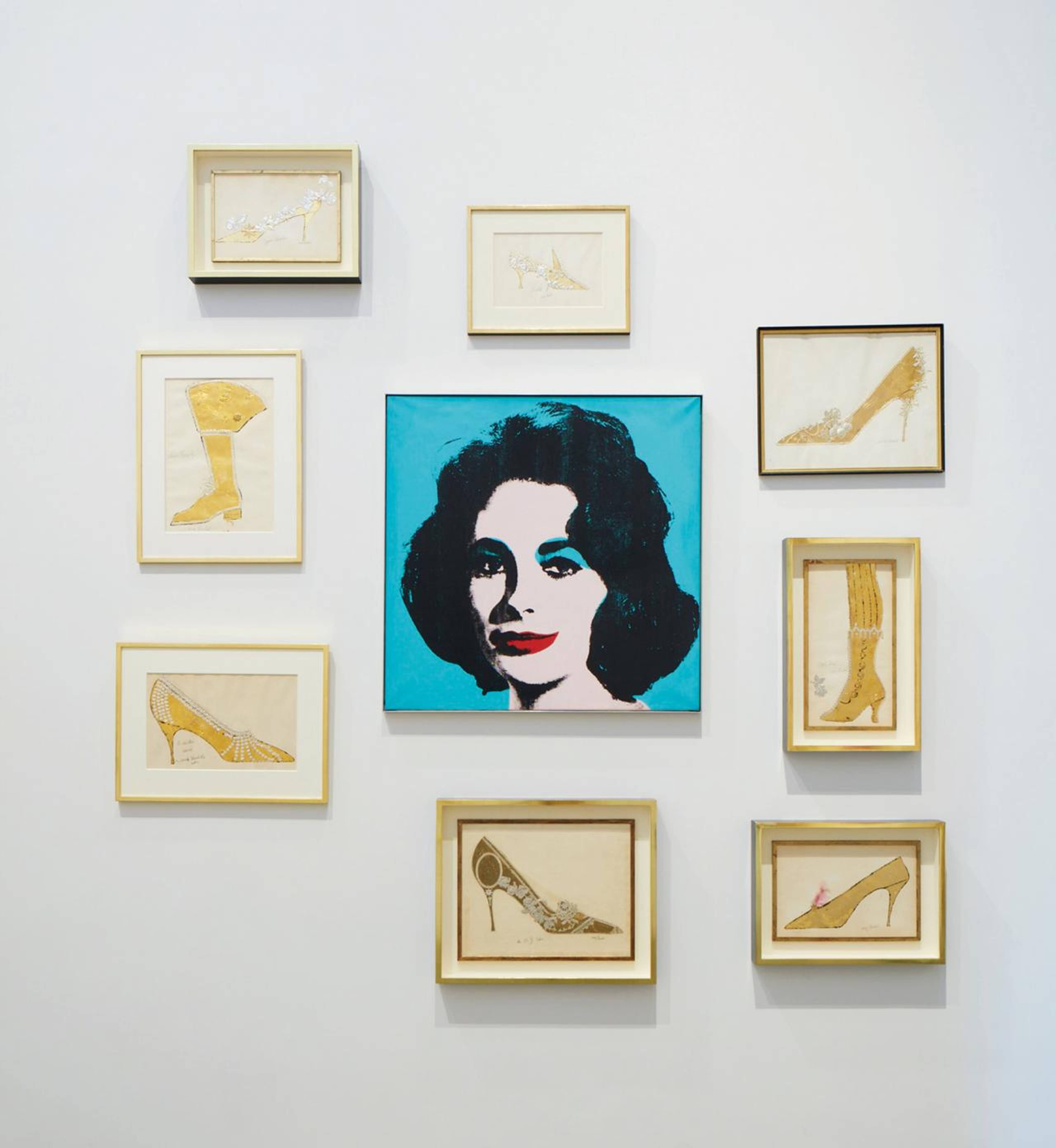“I put my dark glasses back on.”
– Joan Didion, Slouching Towards Bethlehem (1968)
We buy things in order to tell ourselves stories inside of which we can live. A cameo necklace; a squirrel-shaped mink brooch; a “crazy print silk dress with lions and eyeballs.” These are some of the things for sale on novelist Ottessa Moshfegh’s online store in May 2023. They are also the things certain girls like to buy, “interesting” and “unique” girls, girls who think characters are “colorful” and need “stories” and that certain clothes come with them, too. These might be clothes worn by characters in books, for example, or ones owned by a best-selling novelist, or perhaps even ones sporting a character themselves, like a faux-Victorian locket engraved with a woman’s profile. We are talking, in other words, about the kind of girl who hasn’t quite worked out which side of the story she’d like to be on, the telling of it or the being told.
There is, of course, a more elegant and economical solution to this dilemma than purchasing a vintage brooch – which is to write.
Indeed, for 12.50 dollars, one can buy a writing prompt from Ottessa. “I will send you a personally selected photograph from my collection,” the caption reads. “You will write a story inspired by the image. Or not.” Moshfegh’s stories are known less for their “style” than their characters (a drunk sailor, a disturbed and ugly girl, a disturbed and beautiful girl, a disturbed elderly woman, a medieval cripple). Moshfegh has appeared on the cover of Vogue Italia. She has a mole on her face and gives the impression of finding it unfortunate that she is beautiful in spite of it. She has had cat scratch fever. Since last September, she has been using the e-commerce platform Depop to sell clothing from her vintage archive and her personal wardrobe (the Zara dress worn to accept a PEN/Hemingway, the trench coat purchased while writing a murder mystery). Recently, a number of limited editions “made” and “designed” by the author have also appeared in her store: ivory t-shirts with “Unlikable Female Character” emblazoned on a spray of roses, S-XL – Moshfegh poses for the smallest size – and a black-and-white ballpoint. The pen says, “I write what I want.”
Screenshot of Ottessa Moshfegh’s Depop, 14 June 2023. Courtesy: the author
The most widely liked and unique of female characters are sometimes called “it-girls” and, according to a recent feature in New York magazine, this decade has seen an inflation in their number. One Sunday this May, hundreds more hopefuls stood in a line that began at 6:00 a.m. and ended by wrapping around a Broadway block twice. These boys and girls were there to buy “it.” They were there for an event advertised as the “Sale of the Century.” They were there because the things being sold belonged to actress Chloë Sevigny. And Chloë Sevigny – who was “just hanging out in the showroom, talking to everyone and signing whatever” – was there to be liked.
Instead of a mole, Chloë has a noticeable nose. She also has character and style and a special something that comes from their conjunction. Chloë has appeared in campaigns for Miu Miu and Calvin Klein. Her special something creates stories for these brands, stories that would once have been told by photographers and stylists and designers, by line and cut and color rather than plotlines imported from an it-girl’s life. This something is for the most part ineffable, synonymous with few words except, perhaps, “it.” The boys and girls in line dangling paperbacks and outmoded cameras and flavorful vape pens know a few more. Chloë is cool. She has “aura.” (They think so, and so do their mothers.) They like Chloë. They like her a lot.
The only second-hand dress Kim Kardashian has ever worn was Marilyn Monroe’s. She wore it poorly, because Kim has no story, only a life, and this life has nothing to DO with acting, only style.
This is why they will buy the dress Chloë wore when her husband, a director at an art gallery, proposed to her: to be more like Chloë – or, rather, “it.” And so this is what clothing was selling, in New York in the spring of 2023, to the kind of girl who wants to make herself a character: an aura, a word, a cameo.
In midtown that day, another clothing sale – right in Rockefeller Plaza, where one morning this May a pool-blue mirage of a pavilion popped up overnight, an inflatable-looking structure that combines Arc de Triomphe, diving board, and water fountain and is topped by bubbly letters spelling out “SKIMS.” It is a brand name engineered to suggest both its namesake and the bare skin her clothing simulates. The only second-hand dress Kim Kardashian has ever worn was Marilyn Monroe’s. She wore it poorly, because Kim has no story, only a life, and this life has nothing to with acting, only style. And though she has neither writing nor art nor facial blemish of any kind, Kim Kardashian has a form. It is her form for which she is famous and it is forms that were for sale at Rockefeller Plaza.
Chloë’s likable characters seem to dress much like Ottessa’s unlikable ones, only designer: “Funny shapes, PLAID!, anything draped or ruffled or vaguely Victorian looking, hot in a weird way” (in “Miu Miu, Yohji Yamamoto, Vivienne Westwood”), reads the Chloë-sale shopping list of one writer at Harper’s Bazaar. But Kim is not a character, and her clothes are neither ruffled nor funny nor “vaguely” anything; they are a seasonally shifting color palette poured into clean, simple silhouettes. The girls in line at the SKIMS popup do not want to buy SKIMS to be like Kim; they do not want SKIMS to look unique; the girls want SKIMS to look “hot.” And they do. (At least, the good-looking girls look better than ever, and the homelier ones would look worse in plaid.) They look hot in their Seamless Sculpt panties and they look hot in their New Vintage tees and Cotton Rib camis. Most of all, they look hot in their Soft Lounge Slips, last summer’s “viral” dress that still sells out immediately with each new “drop.” The Soft Lounge Slip Dress looks hot in Black and it looks hot in Honeydew and Petal and Army and Cocoa. These colors, so lovely in themselves, recall something Warhol once said about his Marilyn: “it’s beauty, and she’s beautiful and if something’s beautiful it’s pretty colors, that’s all.”
SKIMS pop-up store, New York, 2023
And so one is reminded of where “it” all started. At the big Warhol show at the Brant Foundation in the East Village this spring, there are Maos and Marilyns and flowers and skulls and shoes and dollar signs and electric chairs, each one in turquoise and red and pink and honeydew and peach. Like Kim, Warhol had a couple silhouettes, and he simply reproduced them in many colors. The critics like to say his prints have no “aura,” in other words, character. They are wrong. It is precisely Warhol’s lack of anything equivalent to the idiosyncratically draped or ruffled that make the things inside these paintings so unique, which is to say that I have never been more moved by the difference between death and dancing shoes than when looking at one electric chair done in twelve candy colors.
In death, all manner of things can acquire “it”: blank notebooks; paperweights; rattan furniture; Le Creuset cookware; a photograph of a thin young woman hovering beside her Stingray Corvette, a young woman who would later reappear as an old woman, in a Celine advertisement, wearing dark sunglasses. These are some of the things that were auctioned last year at “An American Icon: Property from the Collection of Joan Didion.” These are some of the things bought for a life that is no longer mine. These are some things that make up a character. I am not sorry to see them go. I no longer have to make up stories in order to live. Now, I am lighter; I have only a form. Wherever there are a pair of Celine sunglasses, there you may find me: floating from one girl’s head to another, looking out, drifting on, passing through the life styles of New York, such as they were in the spring of 2023. The critics liked to say my writing had style; now, my style is the only thing left: a couple parallels made by syntax; a couple scenes placed side by side; a list inside a parenthetical; a repetition of a proper noun; three lines uttered in passing by a couple silly girls on a Manhattan sidewalk; a couple blank notebooks sold for 9,000 dollars at an estate sale in Hudson. I pity those girls in plaid, with their ball-point pens for making up stories. Style is never a fiction, it is only it. And I know it when I see it. Which is to say I never feel more like Joan Didion than when I look in the mirror and see a stranger’s body in Celine sunglasses and a SKIMS Soft Lounge Long Black Slip Dress.
View of “Andy Warhol: Thirty Are Better Than One,” the Brant Foundation Art Study Center, New York, 2023. © The Andy Warhol Foundation for the Visual Arts
___
– This text was originally printed in Spike #76 – An Artist’s Life. You can get it in our online shop –





